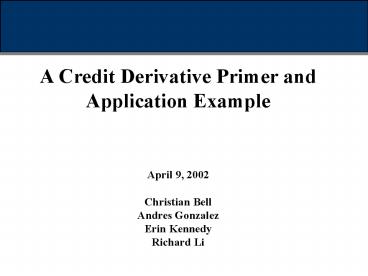A Credit Derivative Primer and Application Example - PowerPoint PPT Presentation
1 / 25
Title:
A Credit Derivative Primer and Application Example
Description:
Credit derivatives are financial contracts between two ... Nordstrom -20. 140. 120. offer. 0. 100. 100. Bid. BBB. Neiman-Marcus. 5. 85. 90. offer. 10. 65. 75 ... – PowerPoint PPT presentation
Number of Views:400
Avg rating:3.0/5.0
Title: A Credit Derivative Primer and Application Example
1
A Credit Derivative Primer and Application
Example April 9, 2002 Christian Bell Andres
Gonzalez Erin Kennedy Richard Li
2
Agenda
What are Credit Derivatives Market
Statistics Credit Derivatives by
Industry Example of Application of Credit
Derivatives
3
What are Credit Derivatives?
Credit derivatives are financial contracts
between two parties that isolate specific aspects
of credit risk from an underlying instrument and
transfer that risk between two parties. In other
words . A credit derivative contract intends to
transfer the risk of the total return in a credit
transaction falling below a stipulated rate,
without transferring the underlying asset. In
even simpler terms Its an insurance policy for
your portfolio against credit risk.
4
Key Aspects of Credit Derivatives
- Reference assets are used to determine payouts.
- Payouts can be derived from
- Loan or bond values
- Default or credit events
- Credit spreads
- Credit ratings
- Credit derivatives are usually transactions that
happen between two professional entities (not
retail). - Credit derivatives allow user to reduce credit
exposure without physically removing assets from
their balance sheets.
5
Credit (Default) Swaps
The credit (default) swap is a bilateral
financial contract in which one counterparty (the
protection buyer) pays a periodic fee, typically
expressed in basis points, in return for a
contingent payment by the protection seller
following a credit event with respect to a
reference entity..Whew!
Protection Buyer
Protection Seller
You may be asking yourself, whats a credit
event?
6
What is a Credit Event
- Failure to meet payment obligations when due
- Bankruptcy
- Repudiation (the refusal of public authorities to
acknowledge or pay debt) - Material adverse restructuring of debt
- Obligation acceleration
7
Total Return Swaps
A Total Return Swap is different from a credit
swap in that it exchanges the total economic
performance of a specified asset for another cash
flow. Payments are based upon changes in the
market valuation of a specific credit instrument,
irrespective of whether a credit event has taken
place.
8
Credit Options
Credit Options are put or call options on the
price of a floating rate bond or loan. Credit
spread options also give end users protection in
the event of a large, unfavorable credit shift,
which falls short of default. Spreads should move
to reflect any downgrading in the credit rating.
9
A History of Credit Derivatives
- New products - only introduced to the market in
the early 1990s (around 1993) - Started by J.P. Morgan, Merrill Lynch, and
Bankers Trust - Market continues to grow faster than other
derivative contracts. - Current market size around 1.5 Trillion (up from
151 Billion in 1996)
10
Players in the Market
- In the 4th Quarter 2001, the 395 Million Credit
Derivatives Market was dominated by 3 large
banks
11
Total Derivatives Market ( billions)
12
Growth of Credit Derivatives Market
13
Breakdown of Credit Derivatives Market
14
CDS Spread Varies Among the Industries
Source Barrons, Bloomberg, WSJ
15
Auto Industry Is Generally 5-7 Bps Tighter
Source Barrons, Bloomberg, WSJ
16
Bank Finance Is Generally Flat to Marginally
Wider
Source Barrons, Bloomberg, WSJ
17
Telecom Industry Is Generally Flat With Two
Exceptions
Source Barrons, Bloomberg, WSJ
18
Retail Industry Is Mixed
Source Barrons, Bloomberg, WSJ
19
Example of a Credit Default Swap
- What is the price of a credit default swap?
- The credit spread on an annualized basis.
- Assuming no liquidity premium
20
Example of a Credit Default Swap
- Therefore, if we buy a bond and buy protection on
that bond, we get a risk less asset, in theory. - Asset Yield 8
- Cost of CDS -2
- Net Yield 6
21
Example of a Credit Default Swap
- What would be a risk-free trade
Protection Seller
Protection Seller
Default Swap Spread
Pay 100
Default Asset
Pay 100
Defaulted Asset
Hedged Investor Protection Buyer
Hedged Investor Protection Buyer
Asset
Libor Fixed Spread
Libor
Borrow 100
Repay 100
Funding
Funding
At Default
Before Default
22
Example of a Credit Default Swap
- CREDIT DEFAULT SWAPS
- 5 year
- Underlying Bid Ask Time
- Citigroup 26.0 33.0 4/03
- Source Dredsner Kleinworth (DrKW Bloomberg Page)
23
Example of a Credit Default Swap
Outstanding 5 Years Floaters 5 year Issuer
Rating Aa2 Citigroup Libor 25-41
BPS Source Dredsner Kleintworth (DrKW Bloomberg
Page)
24
Why Do I Want to Own Credit Derivatives?
- Someone might want to own a credit derivative
because - Diversify portfolio risk without diversifying the
inherent portfolio itself. (Credit Default Swap
CDS-Total Return Swap TRS-Credit Option CO) - Low rated issuers (ie. lending banks) must
finance companies with lower rating than their
own in order to earn interest spreads. Credit
derivatives provide them the ability to profit
from companies with better standing (CDS) - Banks can hedge credit risks without hurting the
banking relationship by not having to sell assets
(CDS or TRS) - Take advantage of credit mispricings (CDS-TRS-CO)
- Trading risk when exchanges collapse (9/11 and
Black Tuesday) - Provides another pricing source for credit ,
similar to interest rate derivatives
25
Credit Derivatives
QUESTIONS?































